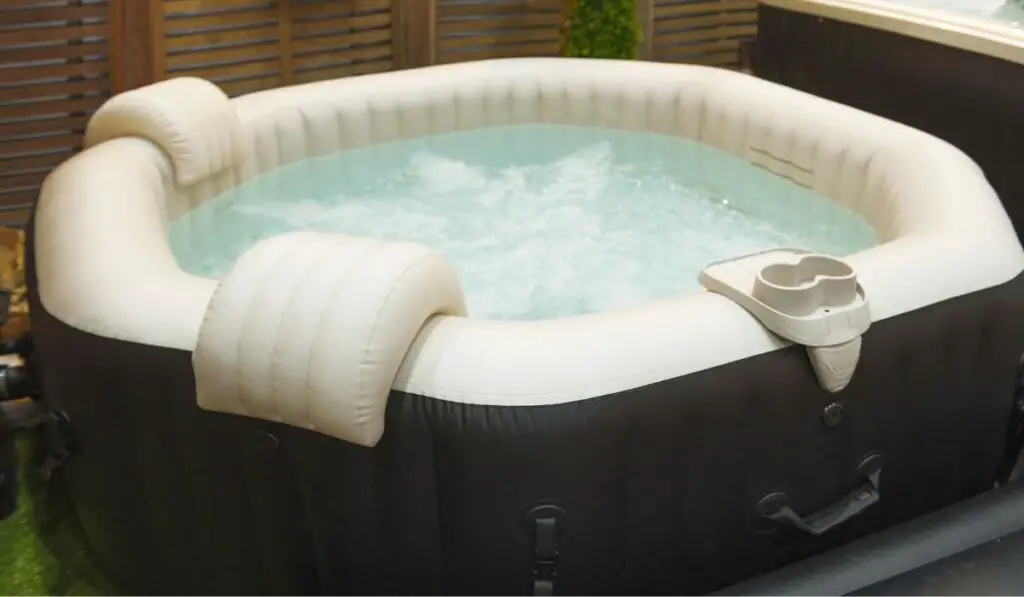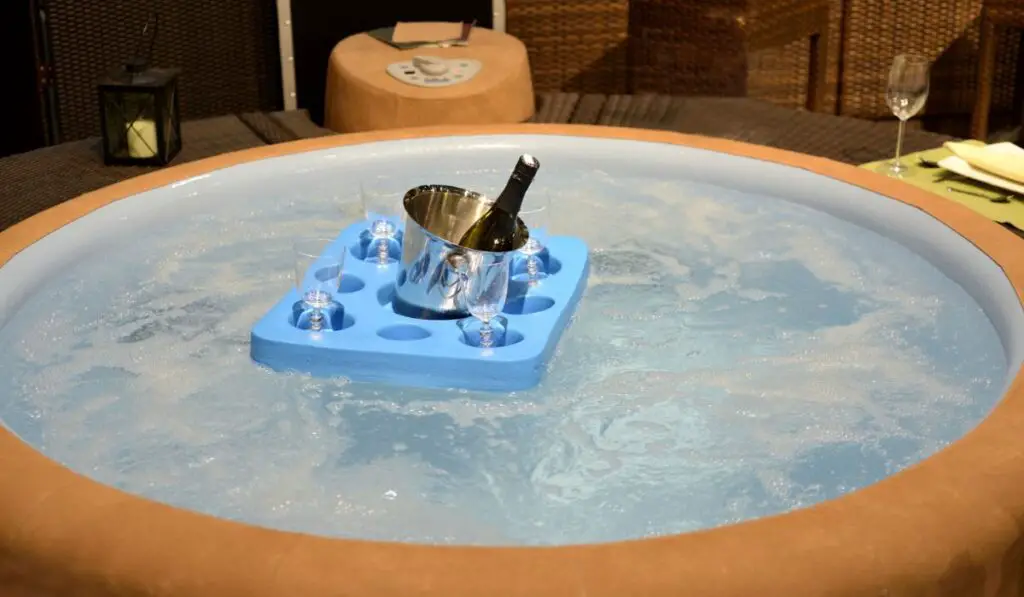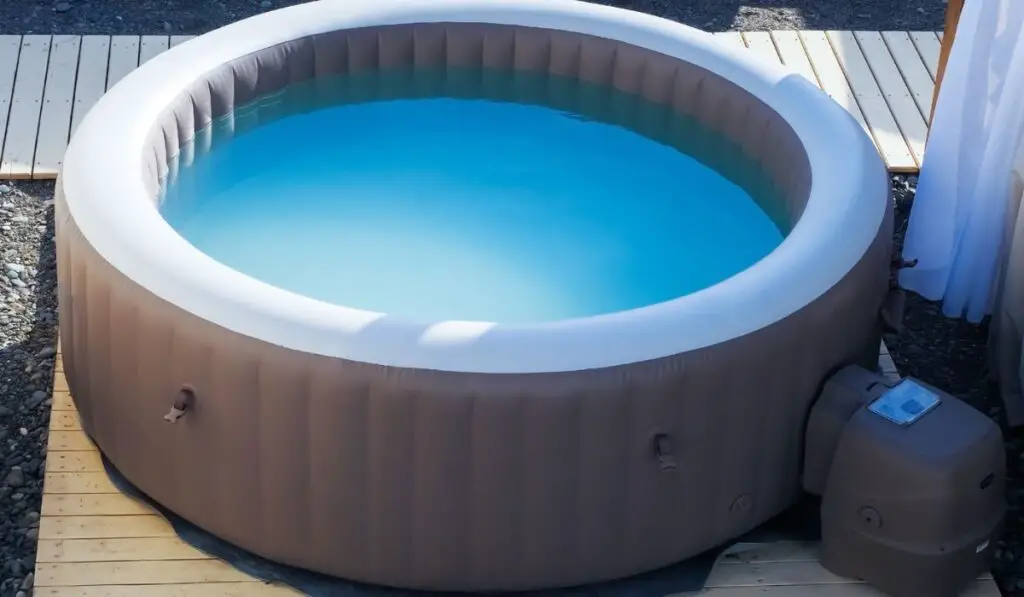Inflatable hot tubs are a great way to get a pool experience without a significant investment. However, many tub owners complain about the operating cost of the tub. The last thing you want is another electricity-heavy appliance. But does an inflatable hot tub really consume a lot of electricity?
An inflatable hot tub has an average 120v 13 amp supply, and some tubs run on 220v. Based on current estimates in the US, the average electricity cost to run an inflatable hot tub is less than $2 per day. However, this may vary based on the price of electricity, tub size, and other factors.
Let’s explore how much electricity an inflatable hot tub uses, how this compares to regular hot tubs and ways to reduce the electricity consumption of your hot tub.
How Much Electricity Does an Inflatable Hot Tub Use?

Generally, most inflatable hot tubs come with a 120v 13 amp supply. However, some inflatable hot tubs are also more powerful and run on 220v. While these consume a lot of electricity, they are rarely used, and most hot tubs are energy efficient.
Inflatable hot tubs have two key electricity components: a circulation pump (jets) and a heater. The circulation pump needs to run every time you use the tub, as you’ll need to keep the water running. You only need to use the heater if the water temperature is cold.
Usually, a hot tub has an 80-watt circulation pump, but the inflatable ones have smaller pumps and are, therefore, more energy efficient.
The electricity consumption of your tub may vary based on the area in which you live.
For example, if you live in cold northern regions, you’ll probably need to run the heater for longer to keep the water warm. However, running the heater more often in the cold may cause an increase in electricity costs.
On the other hand, if you live in the hot central states, the tub will run at a constant temperature of around 98-104 degrees Fahrenheit, reducing the per unit electricity cost.
Your hot tub may consume more electricity if you have added an additional electric component, like tub lights. Tub lights have become very popular in recent years as many people want to have a lightning effect in the water when partying with friends or family.
How Much Does it Cost to Run an Inflatable Hot Tub?

Running an inflatable hot tub costs around $1.2 per day (based on the average electricity cost in the US). Some smaller portable hot tubs cost $1.00 per day to run consistently. However, the cost of running the hot tubs may vary based on various factors like temperature and tub size.
Here are some of the critical factors that can affect the cost of running a hot tub:
- Temperature: The cost of running an inflatable hot tub can increase to $4.5 per day in the winter. You’ll need to keep the heater running longer to maintain it’s temperature, especially in colder climates.
- The Tub’s Condition: On average, inflatable hot tubs last about 2-3 years. When the hot tub is dirty or older, you’ll spend more on heating costs since the water will take longer to heat.
- Repair Costs: Many tub manufacturers give a warranty for a few years. Unfortunately, the warranty doesn’t cover repairing punctures and maintenance. So, it’ll cost you more if you do tub repairs more often.
- Electricity Usage: Portable hot tubs require more electricity than other hot tubs, but inflatable tubs can also be more efficient.
- Frequency of Use: How often you use the tub will significantly affect its overall electricity consumption. Pool professionals recommend that you should use the tub once a day. Using it more than once will increase the running cost as you’ll need to keep the jets and the heater running.
- Type of Filters: The type of filters that you use will also affect the running cost of the tub. High-quality filters will cost you more than double that of low-quality filters, but they are usually more energy efficient and will reduce the effort you need to put into cleaning the tub.
- Type of Tub Water: Believe it or not, you’ll have to consider the cost of replenishing the tub’s water, especially if you have a larger tub. On average, it will cost you around $3 to refill a hot tub, so avoid draining it after every use.
- Cleaning and Sanitizing Costs: Regular cleaning and sanitizing may add to the operating costs, but this is usually quite low.
Keeping your hot tub in good condition and following the proper usage instructions won’t cost you too much to run.
Which Factors Affect the Electricity Cost
You’ll probably consider putting it away if you get higher electricity bills when using an inflatable hot tub. However, there’s no need to skip your spa sessions as it’s unusual that an inflatable hot tub consumes excessive electricity.
Many factors can affect the electricity consumption of a hot tub, including the per unit electricity price in your area, the size of the tub, frequency of use, and the type of heating equipment used in the tub.
Let’s look at each of these factors in detail:
The Price of Electricity
The price of the electricity can affect the electricity cost when you’re using a hot tub. On average, a hot tub costs $1.2 per day based on US households’ average electricity cost in March 2022. However, the cost of electricity can vary depending on where you live.
You’ll usually pay more for electricity if you live in a far-fetched area away from the main supply grid or near an area with heavy electricity consumption. On the other hand, the price of electricity in central states is relatively lower because of lower supply costs.
Some areas will charge you less if you use electricity in non-peak hours, so try heating the tub water in these time slots.
The Size of Your Hot Tub
The size of your tub can also affect the electricity cost to run it. A larger hot tub has more water capacity, and the circulation pumps need to run for longer.
Therefore, running the jets in larger hot tubs will consume more electricity, which increases the cost of using the hot tub.
If you’re using the tub in the winter, you’ll need a heater to warm the water. The heater will also run for longer if the tub size is large. However, like the jets, it’s more expensive to run the water heater in larger hot tubs, especially in colder weather.
Frequency of Use
How often you use the hot tub will significantly affect the electricity cost. You’ll always have to switch on the jets and the heater when you use the tub. If you run them too often, they’ll require more electricity. Eventually, it will cause your high electricity bills.
On the other hand, using the tub twice a week, on weekends maybe, will reduce your electricity costs.
Type of Heating
The type of heating system in your tub will also affect its electricity consumption. The type of heating equipment will vary based on the region where you’re using the hot tub.
For example, if you live in an area with colder winters, you’ll need to install a more powerful heater which will consume more electricity.
The electricity cost will also rise if the quality of the heating material is not good or your hot tub isn’t insulated. If your hot tub consumes more electricity because of a damaged or old heating element, you can replace it to make it more energy efficient.
Installing insulation in the tub will also reduce its electricity consumption.
Tips for Reducing Hot Tub Costs

If your hot tub uses too much electricity, there’s probably something wrong with it, or it may be worn out. Fortunately, you can prolong your hot tub’s lifespan and make it more energy efficient by installing insulation, running the jets in off-peak hours, and maintaining it regularly.
Here are some tips to reduce the cost of using your hot tub:
Install Insulation
You can reduce the running cost of your hot tub by installing insulation around the tub. Insulating insulation will help keep the tub’s water warm for longer. In addition, it will reduce the time needed to keep the heater on, and you won’t need to install additional heating equipment.
After installing insulation, you won’t have to use the heater as often, which prevents wear and tear on the heating element. This will reduce maintenance costs, and you won’t have to replace the heater as often.
Run the Jets and Heater in Off-Peak Hours
One of the most effective ways to reduce the electricity cost of your tub is to run the jets and the heater during off-peak hours. In most areas, using electricity in off-peak hours is cheaper since there’s less strain on the grid.
So, if you’re planning for an evening spa session, try warming the hot tub’s water in the daytime before the evening peak hours.
Clean the Hot Tub Regularly
Cleaning your tub regularly will reduce the strain on the waterjets, filtration system, and other parts, keeping your maintenance costs low.
In addition, if you clean the hot tub according to a set schedule, you won’t need to call a professional to maintain it, and you’ll save on unwanted repair costs.
Leave the Tub’s Heater on in Winter
While it may seem strange, leaving the hot tub on the whole winter is cheaper than switching it off and on repeatedly. Maintain a warm water temperature throughout the day and only crank up the temperature levels before using the hot tub.
This will consume much less electricity throughout the winter than switching it off and then reheating the cold water when you need to use the hot tub.
